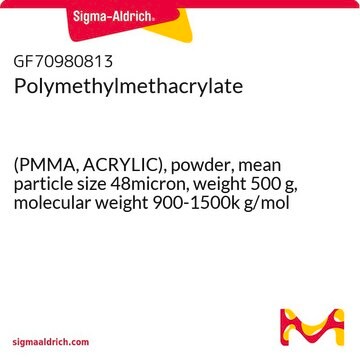03558
Poly(methyl methacrylate)
analytical standard, for GPC, 2,480,000
Sinonimo/i:
PMMA
Autenticatiper visualizzare i prezzi riservati alla tua organizzazione & contrattuali
About This Item
Formula condensata:
[CH2C(CH3)(CO2CH3)]n
Numero CAS:
Numero MDL:
Codice UNSPSC:
41116107
ID PubChem:
NACRES:
NA.24
Prodotti consigliati
Grado
analytical standard
for GPC
Livello qualitativo
Temp. autoaccensione
580 °F
Durata
limited shelf life, expiry date on the label
PM
Mn ~2140000
Mp ~2740000
Mw ~2480000
Solubilità
H2O: insoluble
Densità
1.200 g/cm3
Mw/Mn
~1.16
Temperatura di conservazione
2-8°C
InChI
1S/C5H9O2/c1-4(2)5(6)7-3/h1-3H3
PMAMJWJDBDSDHV-UHFFFAOYSA-N
Cerchi prodotti simili? Visita Guida al confronto tra prodotti
Categorie correlate
Descrizione generale
Poly(methyl methacrylate) is a material, which can be used in the fabrication of micro-fluid chips. It can also find applications in nano-transfer printing, since it can act like a macroscopic mediator in order to handle nanoscale building blocks.
Codice della classe di stoccaggio
11 - Combustible Solids
Classe di pericolosità dell'acqua (WGK)
nwg
Dispositivi di protezione individuale
Eyeshields, Gloves, type N95 (US)
Choose from one of the most recent versions:
Possiedi già questo prodotto?
I documenti relativi ai prodotti acquistati recentemente sono disponibili nell’Archivio dei documenti.
I clienti hanno visto anche
Creation of nanostructures with poly (methyl methacrylate)-mediated nanotransfer printing
Jiao L, et al.
Journal of the American Chemical Society, 130, 12612-12613 (2008)
Development and spectral characterization of poly (methyl methacrylate)/hydroxyapatite composite for biomedical applications
Chen Y, et al.
Development and spectral characterization of poly (methyl methacrylate)/hydroxyapatite composite for biomedical applications, 18(1), 41-45 (2004)
Bo Chen et al.
Journal of controlled release : official journal of the Controlled Release Society, 140(3), 203-209 (2009-05-26)
Water-soluble polymers for the delivery of chemotherapeutic drugs passively target solid tumors as a consequence of reduced renal clearance and the enhanced permeation and retention (EPR) effect. Elimination of the polymers in the kidney occurs due to filtration through biological
Taher Alizadeh et al.
Journal of hazardous materials, 248-249, 401-406 (2013-02-19)
It was demonstrated that a thin film of chemically exfoliated graphene flakes, blended with poly(methyl methacrylate), could be used as a chemiresistor sensor for the sensitive and selective determination of formaldehyde vapor. Formaldehyde adsorption on the sensing film led to
Jose-Luis Ruiz
Journal of the Massachusetts Dental Society, 61(2), 16-19 (2013-03-22)
The literature is replete with articles arguing which is the next best restorative material to substitute porcelain fused to metal (PFM) crowns. Sadly, most of the discussion is about the strength and cost of the materials and often not about
Il team dei nostri ricercatori vanta grande esperienza in tutte le aree della ricerca quali Life Science, scienza dei materiali, sintesi chimica, cromatografia, discipline analitiche, ecc..
Contatta l'Assistenza Tecnica.


